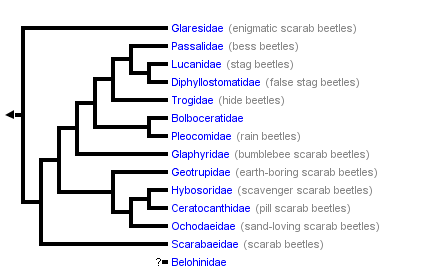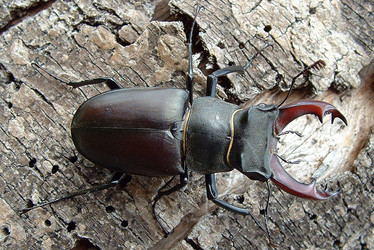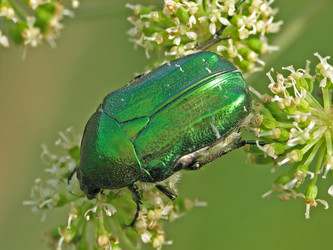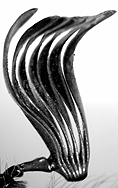Scarabaeiformia
Scarabaeoidea
Scarabs, stag beetles, dung beetles, rain beetles, etc.
D. Jonathan Browne and Clarke H. Scholtz


This tree diagram shows the relationships between several groups of organisms.
The root of the current tree connects the organisms featured in this tree to their containing group and the rest of the Tree of Life. The basal branching point in the tree represents the ancestor of the other groups in the tree. This ancestor diversified over time into several descendent subgroups, which are represented as internal nodes and terminal taxa to the right.

You can click on the root to travel down the Tree of Life all the way to the root of all Life, and you can click on the names of descendent subgroups to travel up the Tree of Life all the way to individual species.
For more information on ToL tree formatting, please see Interpreting the Tree or Classification. To learn more about phylogenetic trees, please visit our Phylogenetic Biology pages.
close boxCharacteristics
Perhaps the most well-known features of adult scarabaeoids are their 3-7 segmented, fan-like or lamellate antennal club and powerful legs armed with teeth on the outer edge, an adaptation for digging.
Left: Antenna of Polyphylla; most scarabaeoids have more compact clubs. Right: Leg of a scarab.
The larvae are typically C-shaped when immobile.
In addition adult scarabaeoids are distinguished by: a highly modified, burrowing prothorax, with large coxae (almost always with concealed trochantins and closed cavities) and usually dentate tibiae with only one spur; hind wings with reduced venation and strong intrinsic spring mechanism for folding; a lamellate antennal club; no hind coxal plates; the second abdominal sternite represented by a lateral portion only; the eighth tergite forming a true pygidium and not concealed by the seventh; four Malpighian tubules (Lawrence & Britton 1991); and 1Ax-2Ax articulation mediated by a well-developed 2Ax medial groove and dorsal ridges (Browne 1993).
Larvae are grub-like with well-developed antennae and legs, no urogomphi, and usually, cribriform spiracles (Crowson 1967, Borror et al. 1989).
Scarabaeoids feed on most types of dung and a wide range of plant and animal matter, from detritus through lower plants to virtually all higher plant tissues and carrion to predation on other insects. Their habits range from free-living through fairly sophisticated forms of brood care to sub-social behaviour (Borror et al. 1989, Scholtz 1990).
The fossil record of scarabaeoids is discussed on a separate page.
Comparative studies within Scarabaeoidea
There have been many broadly based comparative studies covering most major structures including antennae (Iablokoff-Khnzorian 1977), antennal sensilla (Meinecke 1975), eye (Caveney 1986), mouthparts (Nel & Scholtz 1990), prothorax (Hlavac 1975), coxae (Hlavac 1975, Ritcher 1969c), spiracles (Richer 1969a, 1969b), wing venation (Crowson 1967, Iablokoff-Khnzorian 1977), alimentary canal (Scholtz, unpublished), metendosternite (Crowson 1938, Iablokoff-Khnzorian 1977), male genitalia (d'Hotman & Scholtz 1990a, 1990b), female genitalia (Scholtz, unpublished, Holloway 1972, Lawrence & Newton 1982, Tanner 1927), ovarioles (Ritcher & Baker 1974), karyotype (Smith & Virkki 1978, Yadav & Pillai 1979), central nervous system (Scholtz, unpublished, Iablokoff-Khnzorian 1977), spermatozoan number (Virkki 1969), Malpighian tubules (Caveney 1986), larvae (Areekull 1957, Costa et al. 1988, Hinton 1967, Ritcher 1966) and neuropeptides (Browne, unpublished).
Discussion of Phylogenetic Relationships
Scarabaeoid family and subfamily definitions were established by the beginning of this century as were some notions on the evolutionary progression of the taxa. However, these concepts were often intuitively derived (confirmation of many of these traditional ideas has subsequently occurred). The first tangible contributions towards a phylogeny of the Scarabaeoidea were provided by the numerous morphological studies of the superfamily. Apart from providing vital morphological data a rough evolutionary picture of the superfamily also emerged.
The first attempt to apply modern cladistic techniques to the analysis of relationships within the group as a whole was that of Howden (1982). This study, based on 39 characters from 17 taxa, focused on the phylogenetic position of Taurocerastinae (Geotrupidae) in relation to many other scarabaeoid taxa. The study did fulfill one of its major functions in stimulating further investigations of the relationships among the various higher taxa.
The next major study, that of Scholtz (1990), provided a comprehensive review of the available scarabeoid literature. Although the main purpose of this work was to make available a complete data set for future cladistic analysis, some discussion of evolutionary trends was also included.
Browne (1993) and Browne & Scholtz (1995) examined the evolution and morphology of the hind wing articulation, base and venation. Although this study examined all higher scarabaeoid taxa (13 families, most subfamilies, 250 genera) and all taxa identified by Scholtz (1990) as being of uncertain phylogenetic status for the first time, it was very limited in that the resulting phylogram was based on only three character complexes (73 characters). However, there is strong evidence that wing related characters are the most reliable of all structures in elucidating relationships among higher taxa (Kukalov?-Peck 1983).
To date the most comprehensive study is that of Browne & Scholtz (in preparation). They considered all major character suites, 134 characters, which supported most of the relationships presented by Browne (1993) and Browne & Scholtz (1995). The main conclusions of this study are given in the phylogram above.
Although relationships among many taxa are controversial, recent analyses, especially those of Howden (1982), Browne (1993), Scholtz et al. (1994), Browne & Scholtz (1995, in preparation) have resolved the following:
- Glaresidae is the sistergroup of the remaining scarabaeoids and likely reflects the ancestral scarabaeoid due to its large number of unusual plesiomorphies.
- Lucanidae and Diphyllostomatidae together form the sistergroup of the Passalidae.
- Geotrupidae (Geotrupinae, Taurocerastinae and Lethrinae), Hybosoridae, Ceratocanthidae and Ochodaeidae together form the sistergroup of Passalidae, Lucanidae, Diphyllostomatidae, Trogidae, Bolboceratidae, Pleocomidae and Glaphyridae. Together these taxa form the sistergroup of the Scarabaeidae.
However, the following are still heatedly debated:
- Monophyly of the Geotrupidae. Howden (1982) includes Bolboceratinae, Geotrupinae, Taurocerastinae and Lethrinae in this family. Scholtz & Browne (in press) present evidence that this family is polyphyletic and elevated Bolboceratinae to familial status.
- The position of Glaphyridae. Once accorded superfamily status (Hinton 1967) this family has more commonly been placed among the so-called "intermediate" scarabaeoids (Geotrupidae, Hybosoridae, Ceratocanthidae and Ochodaeidae)(Scholtz 1990). Recent evidence suggests that it is a member of the so-called "primitive" scarabaeoids (Passalidae, Lucanidae, Diphyllostomatidae, Trogidae, Bolboceratidae, Pleocomidae and Glaphyridae).
Other Names for Scarabaeoidea
- Scarabaeiformia
- Scarabs, stag beetles, dung beetles, rain beetles, etc.
- Lamellicornia
References
Areekull, S. 1957. The comparative internal larval anatomy of several genera of Scarabaeidae (Coleoptera). Annals of the Entomological Society of America 50: 562-577.
Arnett, R.H., 1968. The beetles of the United States. Ann Arbor, The American Entomological Institute.
Browne, D.J. 1993. Phylogenetic significance of the hind wing basal articulation of the Scarabaeoidea (Coleoptera). Ph.D. thesis, University of Pretoria.
Browne, D.J. and C.H. Scholtz. 1995. Phylogeny of the families of Scarabaeoidea (Coleoptera) based on characters of the hindwing articulation, hindwing base and wing venation. Systematic Entomology 20(3):
Cambefort, Y., 1987. Insectes Coloptres Aulonocnemidae. Faune de Madagascar 69: 3-86.
Caveney, S. 1986. The phylogenetic significance of ommatidium structure in the compound eyes of polyphagan beetles. Canadian Journal of Zoology 64: 1787-1819.
Costa, C., S.A. Vanin and S.A. Casari-Chen. 1988. Larvas de Coleoptera do Brasil. Museum de Zoologia, Universidade de Sào Paulo, Sào Paulo.
Crowson, R.A. 1938. The met-endosternite in Coleoptera: a comparative study. Transactions of the Royal Entomological Society, London 87: 397-416.
Crowson, R.A. 1967. The natural classification of the families of Coleoptera. Classey, Hampton.
d'Hotman, D. and C.H. Scholtz. 1990a. Phylogenetic significance of the structure of the external male genitalia in Scarabaeoidea. Entomology Memoirs 77: 1-51.
d'Hotman, D. and C.H. Scholtz. 1990b. Comparative morphology of the male genitalia of derived groups of Scarabaeoidea (Coleoptera). Elytron 4: 3-39.
Endrödi, S. 1985. The Dynastinae of the World. Budapest, Dr W. Junk Publishers.
Halffter, G. and W.D. Edmonds. 1982. The nesting behaviour of dung beetles (Scarabaeinae). Instituto de Ecologia, Mexico.
Hinton, H.E. 1967. Structure and ecdysial process of the larval spiracles of the Scarabaeoidea, with special reference to those of Lepidoderma. Australian Journal of Zoology 15: 947-953.
Hlavac, T.F. 1975. The prothorax of Coleoptera (except Bostrichiformia - Cucujiformia). Bulletin of the Museum of Comparative Zoology 147: 137-183.
Holloway, B.A. 1960. Taxonomy and phylogeny in the Lucanidae (Insecta: Coleoptera). Records of the Dominion Museum 3(4): 321-365.
Holloway, B.A. 1972. The systematic position of the genus Diphyllostoma Fall (Coleoptera: Scarabaeoidea). New Zealand Journal of Science 15: 31-38.
Howden, H.F. 1982. Larval and adult characters of Frickius Germain, its relationship to the Geotrupini, and a phylogeny of some major taxa in the Scarabaeoidea (Insecta: Coleoptera). Canadian Journal of Zoology 60: 2713-2724.
Howden, H.F. and J.F. Lawrence. 1974. The New World Aesalinae, with notes on the North American lucanid subfamilies (Coleoptera, Lucanidae). Canadian Journal of Zoology, 52(12): 1505-1510.
Iablokoff-Khnzorian, S.M. 1977. Über die Phylogenie der Lamellicornia. Entomologische Abhandlungen der Statlichen Museum für Tierkunde in Dresden 41: 135-199.
Jameson, M. L. and B. C. Ratcliffe. 2002. Series Scarabaeiformia Crowson 1960 (=Lamellicornia): Superfamily Scarabaeoidea Latreille 1802: Introduction. In, R. H. Arnett, M. C. Thomas, P. E. Skelley, and J. H. Frank (eds.), American Beetles. Volume 2. CRC Press, Boca Raton, 861 pp.
Jerath, M.L. 1960. Notes on larvae of nine genera of Aphodiinae in the United States (Coleoptera: Scarabaeidae). Proceedings of the United States National Museum III(3425): 43-94.
Krikken, J. 1984. A new key to the suprageneric taxa in the beetle family Cetoniidae, with annotated lists of the known genera. Zoologische Verhandelingen 210: 3-75.
Kukalov-Peck, J. 1983. Origin of the insect wing and wing articulation from the arthropodan leg. Canadian Journal of Zoology 61: 1618-1669.
Lawrence, J.F. 1982. Coleoptera. In: Parker, S.P. (Ed.) Synopsis and classification of living organisms. New York, McGraw Hill.
Lawrence, J.F. and E.B. Britton. 1991. Coleoptera. In: Insects of Australia. CSIRO, Canberra.
Lawrence, J.F. and A.F. Newton. 1982. Evolution and classification of beetles. Annual Review of Ecology and Systematics 13: 261-290.
Machatschke, J.W. 1959. Untersuchungen ber die verwantschaftlichen Beziehungen der Gattungen der bisherigen Glaphyrinae (Coleoptera: Lamellicornia). Beitrage zur Entomologie 9(5/6): 528-45.
Meinecke, C.C. 1975. Reichensensillen und Systematik der Lamellicornia (Insecta, Coleoptera). Zoomorphologie 82: 1-42.
Nel, A. and C.H. Scholtz. 1990. Comparative morphology of the mouthparts of adult Scarabaeoidea. Entomology Memoirs 80: 1-84.
Paulian, R. 1940. Les caractres larvaires des Geotrupidae et leur importance pour la position systmatique du groupe. Bulletin de la Socie Zoologique de France 64: 351-360.
Ratcliffe, B.C. 1984. A review of the Penichrolucaninae with analyses of phylogeny and biogeography, and a description of a second New World species from the Amazon Basin (Coleoptera: Lucanidae). Quaestiones Entomologicae 20: 60-87.
Reyes–Castillo, P. 1970. Coleoptera Passalidae: Morfologia y division en grandes grupos generos americanos. Folia Entomologica Mexicana 20-22: 1-236.
Ritcher, P.O. 1966. White grubs and their allies. A study of North American scarabaeoid larvae. Oregon State University Press, Corvallis.
Ritcher, P.O. 1969a. Spiracles of adult Scarabaeoidea (Coleoptera) and their phylogenetic significance. I. The abdominal spiracles. Annals of the Entomological Society of America 62: 869-880.
Ritcher, P.O. 1969b. Spiracles of adult Scarabaeoidea (Coleoptera) and their phylogenetic significance. II. Thoracic spiracles and adjacent sclerites. Annals of the Entomological Society of America 62: 1388-1398.
Ritcher, P.O. 1969c. Morphology of the posterior procoxal bridges in Scarabaeoidea (Coleoptera). The Coleopterists Bulletin 23: 89-92.
Ritcher, P.O. and C.W. Baker. 1974. Ovariole numbers in Scarabaeoidea (Coleoptera: Lucanidae, Passalidae, Scarabaeidae). Proceedings of the Entomological Society of Washington 76: 480-494.
Scholtz, C.H. 1986. Phylogeny and systematics of the Trogidae (Coleoptera: Scarabaeoidea). Systematic Entomology 11: 355-363.
Scholtz, C.H. 1990. Phylogenetic trends in the Scarabaeoidea. Journal of Natural History 24: 1027-1066.
Scholtz, C.H. and D.J. Browne. In press. Polyphyly in the Geotrupidae: A case for a new family. Journal of Natural History. Accepted February 1995.
Scholtz, C.H., D. D'Hotman and A. Nel. 1987. Glaresidae, a new family of Scarabaeoidea (Coleoptera) to accommodate the genus Glaresis Erichson. Systematic Entomology 12(3): 345-354.
Scholtz, C.H., D. D'Hotman, A.V. Evans and A. Nel. 1988. Phylogeny and systematics of the Ochodaeidae (Coleoptera: Scarabaeoidea). Journal of the Entomological Society of Southern Africa 51: 207-240.
Smith, S.G. and N. Virkki. 1978. Animal cytogenetics Vol. 3. Insecta 5. Gebrüder Borntraeger, Berlin.
Tanner, V.M. 1927. The female genitalia of Coleoptera. Transactions of the American Entomological Society 53: 3-50.
Virkki, N. 1969. Sperm bundles and phylogenesis. Zeitschrift für Zellfisiologie 101: 13-27.
Yadav, J.S. and R.K. Pillai. 1979. Evolution of karyotypes and phylogenetic relationships in Scarabaeidae (Coleoptera). Zoologischer Anzeiger 202: 105-118.
Zunino, M. 1984. Analisi sistematica e zoogeografica della sottofamiglia Taurocerastinae Germain (Coleoptera, Scarabaeoidea: Geotrupidae). dal Bollettino del Museo Regionale di Scienze Naturali - Torino 2: 445-464.
Information on the Internet
- Scarab Central. Scarab Beetle Research at the University of Nebraska-Lincoln.
- Los Lamelicornios de Costa Rica.
Title Illustrations

| Scientific Name | Lucanus cervus |
|---|---|
| Location | Suffolk, England, UK |
| Specimen Condition | Live Specimen |
| Sex | Male |
| Source | Stag Beetle (Lucanus cervus) |
| Source Collection | Flickr |
| Image Use |
 This media file is licensed under the Creative Commons Attribution-NonCommercial-ShareAlike License - Version 2.0. This media file is licensed under the Creative Commons Attribution-NonCommercial-ShareAlike License - Version 2.0.
|
| Copyright | © 2003 wolf 359 |
| Scientific Name | Cetonia aurata |
|---|---|
| Specimen Condition | Live Specimen |
| Source | Green beetle |
| Source Collection | Flickr |
| Image Use |
 This media file is licensed under the Creative Commons Attribution-NonCommercial-ShareAlike License - Version 2.0. This media file is licensed under the Creative Commons Attribution-NonCommercial-ShareAlike License - Version 2.0.
|
| Copyright | © 2006 Marko Kivelš |
About This Page
D. Jonathan Browne

University of Cape Town, South Africa
Clarke H. Scholtz

University of Pretoria, South Africa
Page copyright © 1995 D. Jonathan Browne and Clarke H. Scholtz
All Rights Reserved.
Citing this page:
Browne, D. Jonathan and Clarke H. Scholtz. 1995. Scarabaeiformia. Scarabaeoidea. Scarabs, stag beetles, dung beetles, rain beetles, etc.. Version 01 January 1995 (under construction). http://tolweb.org/Scarabaeoidea/9077/1995.01.01 in The Tree of Life Web Project, http://tolweb.org/











 Go to quick links
Go to quick search
Go to navigation for this section of the ToL site
Go to detailed links for the ToL site
Go to quick links
Go to quick search
Go to navigation for this section of the ToL site
Go to detailed links for the ToL site